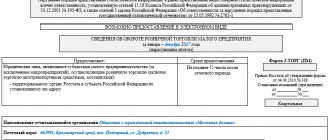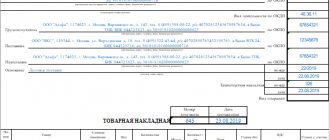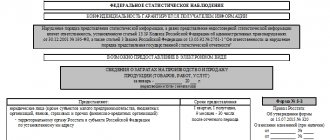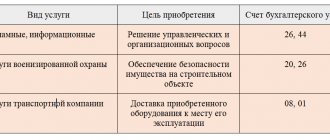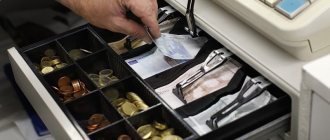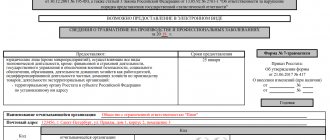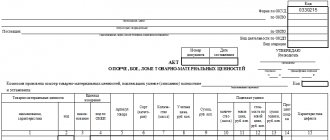What to follow
The current form 3-TORG (PM) was approved along with some other statistical forms by Rosstat order No. 388 dated August 4, 2016 (Appendix No. 7). The same document contains mandatory instructions for filling out 3-TORG (PM).
You can download form 3-TORG (PM) for free to fill out using the following direct link:
“Form form 3-bargaining (pm).”
Responsibility for violation of the delivery procedure
Companies that did not have time or forgot to submit a report bear administrative liability under the Code of Administrative Offenses of the Russian Federation. Similarly, fines are provided for false information in the report.
For the first violation, legal entities face a fine of 20 to 70 thousand rubles, and for repeated cases the fine increases significantly and ranges from 100 to 150 thousand rubles.
During the coronavirus pandemic, Rosstat canceled liability measures. Thus, in May 2021, the measures provided for in Article 13.19 of the Code of the Russian Federation on Administrative Offenses are not applied. This is due to the continued high alert regime in a number of regions of Russia.
Rules: how to fill out 3-TORG (PM)
First, a general approach on how to fill out form 3-TORG (PM). They do this:
- based on the cumulative total principle;
- as a whole for the trading enterprise, taking into account “special features”.
In addition, the procedure for filling out 3-TORG (PM) has some features depending on who exactly is engaged in retail sales (see table below).
| Features of filling out 3-TORG (PM) | |
| Retail trade entity | Filling Features |
| Simple partnership (joint activity agreement) | The cost of goods sold by comrades is distributed according to the value of their contributions to the common cause (the form is filled out by each of them). A different procedure may be prescribed by the partnership agreement or another agreement. If the cost of goods cannot be distributed among the partners, then the form is handed over for everyone by the partner who keeps records of the common property. |
| Legal entities - commission agents/attorneys/agents - in retail trade in the interests of another person under commission/mandate/agency agreements | Shows the actual cost of goods sold to the public |
| Principals, principals, principals – owners of goods | Form 3-TORG (PM) is not filled out, since the relevant data is provided by a company (usually a commission agent) that directly sells goods to the public |
According to the procedure for filling out 3-TORG (PM) in 2021, this form must indicate the actual postal address if it does not coincide with the legal one. And the OKPO code is taken from the notification of its assignment from the local Rosstat authority.
Also see “3-TORG (PM) in 2021.”
Section 1
First of all, the procedure for filling out form 3-TORG (PM) requires showing retail trade turnover:
- for the quarter;
- for the same quarter last year.
We are talking about revenue from the sale of goods to the public for personal consumption or home use for cash or paid for in other ways.
Thus, retail turnover includes the full cost of:
- goods sold to the public on credit;
- medicines dispensed to certain categories of citizens free of charge or on preferential prescriptions;
- coal;
- gas in cylinders;
- wood fuel;
- other goods sold to certain categories of the population at a discount.
The cost of goods sold through the retail trade network is not included in retail turnover:
- legal entities (including social organizations, special consumers, etc.);
- to businessmen.
A mandatory feature of a retail transaction is the presence of a cash receipt (invoice) or other document replacing the receipt.
The current rules for filling out 3-TORG (PM) indicate that the retail price includes:
- trade margin;
- VAT;
- similar mandatory payments.
For the purposes of line 03, Internet trading is the sale of goods based on orders from buyers received online, where the price and/or terms of sale are accepted or negotiated over the Internet, e-mail, etc., regardless of the form calculation and method of delivery of goods.
The cost of goods sold through online stores is determined by the time of invoice issuance or delivery to the buyer. That is, the moment the buyer actually pays for the goods does not play a role.
Mail order (page 04) is the retail sale of any product through mail orders. They are selected from advertisements, catalogues, samples or other types of advertising.
Inventories of goods purchased externally and intended for sale to the public (page “05”) are valued at the average selling prices for similar goods that were in effect in the reporting quarter and the corresponding quarter of the previous year. That is, on the balance sheet they are accounted for at the acquisition price, and on line 05 - at average prices.
In addition, data on inventories of goods is provided for all places of their storage, including rented ones:
- warehouses;
- cold storage warehouses;
- in shops.
Goods accepted from the population on commission are not included in the volume of inventories.
Companies - commission agents, attorneys and agents, when acting in the interests of another person, do not fill out line 05. This is done for them by the owners of the goods - principals, principals, principals.
Section 2
In part of Section 2, filling out 3-TORG (PM) statistics implies a detailed decoding of the data in line 01 of Section 1.
| How to fill in individual lines | |
| Line no. | What to indicate |
| 06 | Fresh, chilled, frozen or canned meat of animals, poultry Meat products and canned food Game meat By-products from animal meat, poultry, game |
| 07 | Beef, pork, veal, lamb, goat meat, horse meat, rabbit meat and other types of animal meat. Please note: sales and inventories of meat by-products are reflected only on line 06 |
| 08 | Meat of chickens, chickens, guinea fowl, geese, ducks, turkeys and other poultry. Please note: sales and inventories of poultry by-products are reflected on line 06 |
| 09 | Meat and poultry products: · boiled, semi-smoked, hard smoked and other sausages; · sausages and sausages; · smoked meats; · meat snacks; · semi-finished products (meat cutlets, meat and vegetable cutlets and with other fillings, dumplings, pancakes and pies with meat, meatballs, minced meat, etc.); · quick-frozen semi-finished products (with and without garnish); · culinary products from meat, including home-made; · meat bouillon cubes. |
| 11 | Live fish, chilled, frozen, salted, spicy salted, marinated, smoked, dried, dried, balyk products, caviar (by weight and in jars), crustaceans, shellfish and other seafood, canned fish in oil, tomato sauce, natural canned fish, fish vegetables canned food, preserved fish from herring, sprat, mackerel and other types of fish and seafood. |
| 13 | Animal and vegetable oils, margarine products, mayonnaise, mayonnaise sauces. |
| 14 | Butter (salted, unsalted, Vologda, amateur, peasant, dietary, etc.), ghee, butter with fillers (cheese, chocolate, etc.). |
| 15 | Refined and unrefined vegetable oils: sunflower, peanut, mustard, soybean, corn, sesame, flaxseed, olive, rapeseed, salad, etc. |
| 16 | Margarine products (milk, cream, dairy-free margarine, confectionery and cooking fat) |
| 17 | Drinking milk, milk drinks without fillers and with fillers, fermented milk products and drinks (yogurt, fermented baked milk, kefir, yogurt, kumiss, etc.), cream, sour cream, cottage cheese, curd cheeses, curd mass, curd semi-finished products (dumplings, cheesecakes, etc.), cheeses, canned milk, freeze-dried canned milk powder, condensed and concentrated milk. |
| 18 | Drinking milk, whole, bottled, pasteurized, sterilized |
| 19 | Pasteurized, sterilized milk drinks (reconstituted milk), made from whole cow's milk powder, without fillers |
| 23 | Sugar, powdered sugar, xylitol, sorbitol, other sweeteners |
| 24 | Flour and sugar confectionery products |
| 25 | Tea, coffee, cocoa, as well as herbal teas, children's teas, coffee drinks, capsules for coffee machines, chicory (with and without additives), tea and coffee gift sets (with cups, spoons, candies, etc.) |
| 28 | Flour, flour product concentrates for making cakes, pastries, muffins, cookies, buns, pies, dumplings and other flour dishes, as well as baby flour nutritional mixtures |
| 29 | Cereals, as well as porridges for baby food, infant formula based on cereal decoctions |
| 31 | Bakery products (bread of all types, bakery, bagel products, pies, pies, donuts, etc.), as well as crackers, croutons, crispbread |
| 35 | Alcoholic drinks, including beer and beer drinks |
| 36 | Vegetable and fruit juices, mineral water, bottled drinking water and other non-alcoholic drinks |
| 38 | Chewing gum, food additives, dietary supplements, herbs, spices and other food products not included in other lines |
| 40 | Cosmetic and perfumery products, except soap |
| 42 | Refrigerators and freezers, dishwashers, household washers and dryers, household cooking and heating equipment, sewing machines, vacuum cleaners and other electrical household appliances |
| 45 | Audio equipment, televisions, video recorders, video cameras, home theaters |
| 46 | Audio equipment, which includes tape recorders, tape recorders, decks, stereos, players, radios, tuners, amplifiers, equalizers, speakers, voice recorders, car audio equipment, players with a laser optical reading system for CDs, record players. |
| 47 | Plasma, projection, CRT TVs, LCD TVs, etc. |
| 49 | Ski equipment, water sports equipment, equipment and equipment for physical education, athletics, other sports or outdoor games, special sports shoes (ski boots, football boots, boots with attached skates, etc.). Please note: this line does not reflect sales and inventories of sportswear and footwear such as sneakers. |
| 50 | Fully equipped computers, including tablets (iPads), laptops, netbooks |
| 51 | Monitors, printers, speaker systems, mice, keyboards, touchpads, touch screens, microphones, scanners, web cameras, video capture devices, TV tuners, devices used to store information processed by a computer (HDD, HDD, USB flash drive) storage device). |
| 52 | Cameras, lenses, flashes, memory cards, tripods, filters, digital photo frames, batteries, chargers, film, etc. |
| 53 | Mobile phones, including iPhone, smartphones |
| 54 | Bicycles and motorbikes, including children's bicycles |
| 55 | Books |
| 60 | Men's, women's and children's coats, short coats, raincoats, jackets, overalls, suits, jackets, trousers, dress items, skirts, blouses, vests, trouser sets and other outerwear, including outerwear. Please note: this line does not reflect sales and inventories of sportswear and leather clothing. They are shown on line 82. |
| 61 | Underwear: briefs, pantaloons, underpants, nightgowns, pajamas, bathrobes and dressing gowns, slips, petticoats, negligees, T-shirts, sweatshirts and other underwear, including linen knitwear. |
| 64 | Men's, women's and children's shoes made of any material and for different purposes, except for special sports shoes (ski boots, football boots, boots with attached skates, roller skates, etc.) |
| 65 | Timber, brick, cement, crushed stone, gravel, sand, lime, gypsum, concrete mixtures, ceramic well pipes, tiles, mastic, putty and primer compounds, and other building materials. Please note: this line does not reflect sales and inventories of hardware, paints and varnishes, hand tools, construction accessories, gardening equipment and tools, metal and non-metal building structures, prefabricated wooden houses. They are shown on line 82. Line 65 = 47.52.71 + 47.52.72 + 47.52.79 |
| 67 | Products used for medical purposes, orthopedic products, except medical equipment. Please note: information on medical equipment is shown on line 82. Line 67 = 47.74.10.000 + 47.74.20.000 |
| 69 | Jewelry made from precious metals and stones |
| 70 – 74 | Various types of motor fuel through gas stations (including MTZS, CNG filling stations, AGZS, CryoGZS). In columns 6 and 7 – motor fuel reserves intended for retail trade. Please note: they do not reflect the sale of motor fuel to legal entities, nor the volumes of gas sold for refilling gas cylinders. |
| 76 | Tires and other car parts, assemblies and accessories, both new and used, except car radios |
| 77 | Motorcycles, scooters, ATVs, snowmobiles, mopeds, both new and used |
| 82 | Non-food products not included in other lines (souvenirs, handicrafts, objects of worship and religious purposes, funeral supplies, pets, bark for animals, birds, fish, feed, feed mixtures, flowers and other plants, seeds, fertilizers, liquid boiler fuel, bottled gas, wood fuel, etc.). |
Lines 01 – 82 are given with one decimal place after the decimal point.
Section 3
The instructions for filling out the 3-TORG (PM) form included the presence of a gas station in a separate section. The peculiarity is that Section 3 “Number of gas stations” is filled out only once a year in the report for January – March.
The structure of the report and the procedure for filling it out
Instructions for filling out the form are given in the same Rosstat orders that approved their forms. There are no fundamental updates in the instructions due to changes in the form.
- from the organizational (introductory) part, filled in with a standard set of information about the reporting company;
- 3 main sections.
Section 1 “Retail trade turnover”
The section is represented by a table of 4 columns and 5 lines. It provides data as of the reporting date in comparison with the same period last year.
Retail trade volume is reflected in actual sales prices, which include:
- trade margin;
- VAT;
- similar mandatory payments.
Data in the report should not include retail trade turnover:
- in the form of the cost of goods sold at retail to firms and individual entrepreneurs;
- catering turnover
The retail turnover reflected in the report includes those transactions that are confirmed by a cash receipt or a document replacing it.
The section contains data:
- on retail trade turnover with detailed data on food products and methods of sale (via the Internet or by post);
- on the stock of goods for sale to the public at the end of the period.
“Distribution trade on UTII: features of the legislation” will tell you about the tax nuances of one of the types of retail trade .
Section 2 “Retail sales and inventories of goods by type”
The second section of the report explains the figures from section 1 on retail turnover and product inventories. Explanations are given in lines 06–82 at the cost of certain types of food and non-food products sold to the population and in stock at the end of the reporting period (meat, fish, dairy products, fresh fruit, vacuum cleaners, refrigerators, televisions, shoes, building materials, medicines, etc. ).
Each product group in the report is listed under the corresponding code from the classifier of products by type of economic activity (OKPD2).
Section 3 “Number of gas stations”
Lines 83–85 of the third section of the report are filled out once a year - only in reporting for the 1st quarter. It includes information on the number of gas stations with details by type of gas station:
- multi-fuel (MTZS);
- gas filling stations (CryoGZS, CNG filling stations, AGZS).
Read about the nuances of using modern cash registers for the retail sale of gasoline in the material “Online cash registers for gas stations from 2021 - explanations .
Control ratios
Correct completion of 3-TORG (PM) requires the following conditions to be met:
- page 01 ≥ page 02 (columns 3-4);
- page 01 ≥ page 03 (gr. 3-4);
- page 01 ≥ page 04 (gr. 3-4);
- page 01 MINUS page 02 (gr. 3 and 4) = page 39 + 40 + 41 + 42 + 45 + 48 + 49 + 50 + 51 + 52 + 53 + 54 + 55 + 56 + 57 + 58 + 59 + 60 + 61 + 62 + 63 + 64 + 65 + 66 + 67 + 68 + 69 + 70 + 71 + 72 + 75 + 76 + 77 + 78 + 82 (gr. 4 and 5);
- page 02 (gr. 3 and 4) = 06 + 11 + 13 + 17 + 22 + 23 + 24 + 25 + 27 + 28 + 29 + 30 + 31 + 32 + 33 + 34 + 35 + 36 + 37 + 38 (gr. 4 and 5);
- page 05 (gr. 3 and 4) = 06 + 11 + 13 + 17 + 22 + 23 + 24 + 25 + 27 + 28 + 29 + 30 + 31 + 32 + 33 + 34 + 35 + 36 + 37 + 38 + 39 + 40 + 41 + 42 + 45 + 48 + 49 + 50 + 51 + 52 + 53 + 54 + 55 + 56 + 57 + 58 + 59 + 60 + 61 + 62 + 63 + 64 + 65 + 66 + 67 + 68 + 69 + 70 + 71 + 72 + 75 + 76 + 77 + 78 + 82 (gr. 6 and 7);
- page 06 (for all columns) ≥ 07 + 08 + 09 + 10;
- page 11 (for all columns) ≥ page 12;
- page 13 (for all columns) ≥ 14 + 15 + 16;
- page 17 (for all columns) ≥ 18 + 19 + 20 + 21;
- page 25 (for all columns) ≥ page 26;
- page 42 (for all columns) ≥ page 43 + 44;
- page 45 (for all columns) ≥ page 46 + 47;
- page 72 (for all columns) ≥ page 73 + 74;
- page 78 (for all columns) ≥ page 79 + 80 + 81;
- page 83 ≥ page 84 + 85.
Read also
15.05.2017
Sample report on retail turnover
Let's look at an example of how to fill out form 3-TORG (PM).
LLC "Molochnaya Dolina" is a small enterprise engaged in the sale of dairy products to the population. In 2021, through a network of retail stores, Molochnaya Dolina LLC sold milk, fermented baked milk, kefir, sour cream, cottage cheese and cheese in the amount of RUB 12,341,000. Inventories of dairy products as of December 31, 2017 amounted to RUB 4,987,670 in value equivalent.
When registering 3-TORG (PM), a company is required to fill out the introductory part, section 1 and 3 explanatory lines from section 2 (17–21), taking into account the following detail:
What applies to wholesale trade?
Monthly PM-torg form - how to fill out? The report “Information on wholesale trade turnover of a small enterprise” is easy to fill out; it contains only one indicator - wholesale trade turnover, which is indicated for several periods:
- for the reporting month;
- for the past month;
- for the same month last year.
When filling out information for the reporting company, you must indicate:
- the full name of the organization and write a short name next to it in brackets;
- index and legal address of the company, if the location differs from registration, then note the actual address;
- OKPO, assigned by statistics, this code can be “seen” in the form of a balance sheet in the organization’s code line.
After filling out the report, it is signed by the head of the company or the official responsible for reporting, the telephone number and date of preparation are indicated - and the report can be considered ready if you know the nuances of the presentation and what income is not considered wholesale turnover for the purpose of filling out this information. This will be discussed further in the article.
The PM-torg form is filled out on a form approved by Rosstat order No. 321 dated July 16, 2015, and is submitted monthly to the territorial statistics body, the deadline for submission is the 4th of the previous month.
Wholesale trade for the purpose of filling out the main indicator in line 01 of the PM-trading form is considered to be:
- the cost of goods shipped with the obligatory completion of an invoice;
- proceeds from goods sold purchased for subsequent sale to legal entities and individual entrepreneurs for further use or resale;
- if the turnover includes the sales price with a markup, VAT, excise tax, customs duty, and all mandatory payments;
- for commission agents (agents) - remuneration if they carry out activities in the interests of another person (principal, principal) is reflected with value added tax at the actual cost;
- for principals - the turnover of trade carried out by the principal (principal) on the basis of commission agreements or agency agreements is indicated at the cost of goods sold.
Turnover on line 01 is indicated in thousands of rubles with one decimal place after the decimal point.
The following is not considered a wholesale sale for the purpose of completing this statistical report:
- sales of products to the public, since this is retail trade;
- revenue from the sale of fuel cards, telephone cards, communication services, as well as from the sale of lottery tickets;
- the cost of utilities provided to the population and enterprises (gas, water supply, electricity).
Statistical reporting in the PM-torg form is mandatory for small wholesale businesses (except micro-enterprises). Retail trade organizations do not submit this report. When completing the main indicator, you must include turnover, which is considered wholesale only for the purpose of completing this report form. This information is submitted to Rosstat monthly on the 4th of the previous month.
The Federal State Statistics Service collects information on the turnover of small enterprises engaged in wholesale trade. To collect such information, Rosstat Order No. 321 dated July 16, 2015 (as amended on August 28, 2017) approved the monthly PM-torg form. Data is filled in for the organization as a whole, that is, for all “isolations” (branches and structural divisions), regardless of their location.
PM-trading – who submits this report? This form is submitted by all legal entities - small businesses (with the exception of micro-enterprises) engaged in wholesale trade. provide information on trade turnover on a general basis. If the organization is temporarily not operating, but trade was still carried out for part of the reporting period, it is necessary to submit information about turnover in the general manner (indicating the date of suspension of activity).
PM-bargaining – due date: until the 4th day of the month following the reporting month (inclusive). The organization fills out the current form for providing information and submits it to the territorial body of Rosstat at its location. If the activity is not carried out at the location, then the form must be submitted to the place where the activity is actually carried out.
Who is required to submit?
All companies must complete this form:
- who are engaged in retail trade;
- where 16-100 people work both on a permanent basis under an employment agreement and part-time;
- who provide catering services.
Most of the territorial divisions of Rosstat have posted on their official websites a list of enterprises that must fill out and submit quarterly Form 3 TORG PM.
Who must submit reports?
Not all enterprises have an obligation to provide (see figure):
Don't know your rights? Subscribe to the People's Adviser newsletter. Free, minute to read, once a week.
The following are not exempt from submitting the form:
- small enterprises on a simplified taxation system - they submit reports according to generally accepted rules;
- firms that have worked for an incomplete reporting period are required to submit the PM-torg form, indicating in writing the period of inactivity;
- companies in bankruptcy - only after making an entry about liquidation in the Unified State Register of Legal Entities, the organization is exempt from submitting a report.
Presentation nuances:
- Legal entities provide information at the place of registration; if there is no activity at the location, the company sends a report to the place of activity.
- If the company includes branches and divisions located in different regions, reporting is submitted as a whole for the entire organization at its place of registration.
- The main business company submits a report without taking into account the turnover of subsidiaries and dependent companies, which, in turn, also provide information on their activities in a separate form.
- If the company is in trust management, then the enterprise carrying out management is accountable for it as for an entire property complex.
- Enterprises operating under a simple partnership agreement distribute wholesale trade turnover in proportion to their contributions, unless this contradicts their agreement, and each entity submits a report. If it is impossible to distribute the proceeds, the PM-torg form is submitted by the comrade performing reporting duties.
- If there are no reporting indicators, you should send a letter about this to the statistical office. This must be done every time the form is due, since zero reports are not submitted to Rosstat, and penalties for failure to submit may be assessed (letter of Rosstat dated January 22, 2018 No. 04-4-04-4/6-smi).
Any company can be included in a sample survey organized by a statistical agency. In this case, Rosstat notifies the enterprise in writing of the need to report on this form.
